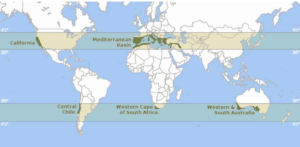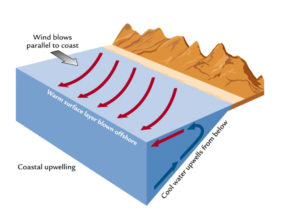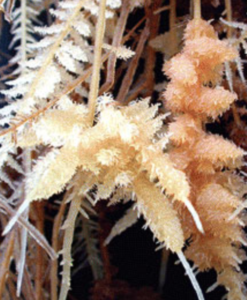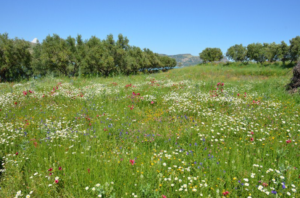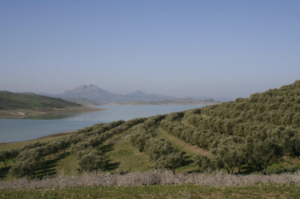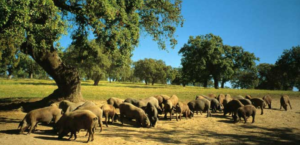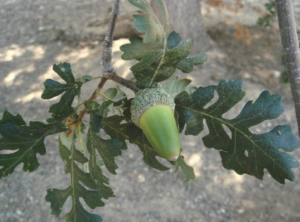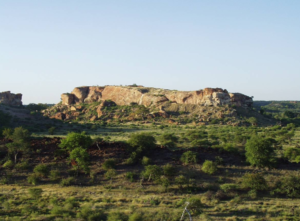Coastal California, central Chile, parts of South and Western Australia, the Western Cape of South Africa and of course the Mediterranean Basin itself. These are the few and relatively isolated areas across the globe which fit the description of a Mediterranean Climate Region. Sometimes referred to as drysummer subtropical or ‘CSA’ in theKöppen climate classification system,these regions have long, hot, dry summers; mild, wet winters and are found predominantly on the west coasts of continents approximately between 31 and 40 degrees latitude north and south of the equator.
Map of Mediterranean Climate Regions
[Image] At: http://gimcw.org/climate/mapworld.cfm (accessed on 22.3.2014)
Covering a mere approximate 5% of the world’s land mass, the Mediterranean climate regions(MCR) of the world represent a far larger portion of our popular global culture. The Mediterranean Basin itself, from which the systems take their name, bore incalculable influence upon world politics and history; it’s shores shared and fought over at various times by the Egyptians, Phoenicians, Assyrians, Greeks, Romans, Moors, Ottomans and more. These powerful, far travelling peoples opened trade routes across the ‘old world’, discovering what were to them previously unknown plant species, spreading them as they travelled on and of course returning with them home to the Mediterranean Basin and from there to the ‘new world’.
‘’…the agriculture of the Mediterranean has played a major role in the agriculture of the western world, and on this ground alone deserves discussion.’’
~ D. B. Grigg,The Agricultural Systems of the World: An Evolutionary Approach.
The different MCRs of the world have their obvious similarities and of course considerable differences. Common amongst them is the development of Sclerophyll ecology. Sclerophyll literally means ‘hard leaf’ and refers to the tough, smooth leaves borne on the plants growing there, common across numerous, unrelated families, perfectly adapted to the long, hot, dry summers. Think of an Olive leaf, a classic example, with leathery texture and waxy coating. This is to be found on many plants in these regions. Carobs in southern Europe and north Africa, Eucalypts and Acacias in Australia, Proteas in South Africa, and Live Oak in California’s Chaparral systems…
Wild fire too is a common occurrence across MCRs, playing a rejuvenating role by clearing out built up litter and in many cases initiating the germination of fire dependant species. In some places like California and notably throughout the southern Australian latitudes the interruption of indigenous fire stick agriculture management makes for a massive build up of litter and subsequent devastating bush fires far beyond the intensity the native population would have controlled using traditional methods.
All MCRs are found directly on the coast of oceans, the Mediterranean Basin sitting in part on the Atlantic and in part harbouring it’s own eponymous sea. Coupled with their latitudes
it is this proximity to the Ocean that has such moderating effect on temperature and humidity. Each MCR is located near a permanent high pressure atmospheric cell that hovers over the ocean. It is the seasonal movement of these cells that keep MCRs wet in winter and dry in summer. Another influential ocean phenomena known as upwelling causes deep, cold and very nutrient rich waters to ‘well up’ to the surface near land. The resulting phytoplankton blooms and kelp forests support massive communities of fish and other marine life. Four of the major upwelling ocean zones overlap with MCRs(upwelling in south west Australia is far less dependable) making their waters some of the most historically important seafood producing zones on Earth. Upwelling causes an exaggerated difference between land and ocean temperatures during summer. This phenomena is responsible for large amounts of moisture laden fog to be blown in land during the hotter months. In many parts of MCRs this fog goes a long way to supplement soil moisture when and where there is sufficient vegetative cover/biomass to harness it. This extra moisture makes it possible for the growth of such immense tree species as the Sequoia sempervirens in California(the tallest trees in the world), Eucalyptus regnans in south eastern Australia(the second largest tree in the world) and Eucalyptus diversicolor in Western Australia(worlds second largest flowering hardwood). Such fog is usually restricted to coastal areas except where there are rivers and valleys to channel it further inland. However other effects of these unusually cold coastal waters reach much further inland. Being so cold they evaporate far less than other coastal waters(eg. sub tropics, tropics), inhibiting the formation of summer rain clouds, adding in part to MCRs classic, long, hot, dry summers.
The mechanisms of Upwelling.
[Image] At: http://www.sonoma.edu/users/f/freidel/global/372lec2images.htm (accessed on 22.3.2014)
MCRs all differ in their geology however two main distinctions have been made and are worth noting. The regions of the Mediterranean Basin, California and central Chile are geologically ‘young and active’. Between tectonic activity and recent glaciation their soils are relatively mineral and nutrient rich. Conversely termed as ‘old and stable’, South Africa and especially Australia are far more ancient land masses, the latter having seen no major glaciation since the Permian period(+275 million years ago). The last eruption of an active volcano on the Australian mainland was approximately 5000 years ago near Mt Gambierin South Australia. In the distant pastlarge portions of the young/active MCRs were inundated by shallow seas while the old/stable MCRs were already dry, exposed land and so their soils are now weathered and leached of fertility. To cope with these conditions much of the plant life has developed techniques making them super efficient at the uptake of certain minerals, so much so that families like the Proteaceae, common to both old/stable antipodean regions, find normal levels of soil Phosphorus toxic.
“Proteoid roots of Banksia prionotes, Acorn Banksia.”
(Image) A/Prof Michael W Shane, University of Western Australia
Mediterranean Climate Regions are in many ways like environmental edge zones unto themselves, neighbouring one or all of Semiarid, Temperate and/or Subtropical climate regions. For horti/agro/silvicultural applications, MCRs are extremely flexible and can see plant and animal species from many different climate types thrive with due attention paid to microclimate.
All of the Mediterranean regions of the world at one place or another border semiarid leading to arid environments. The plants of these areas are of course adapted to growing in brittle environments(not just low precipitation but low atmospheric and soil humidity). Mediterranean summers can be said to closely resemble those of the semiarid, the main difference being that Mediterranean environments in most cases receive much higher winter precipitation. Many plants adapted to semiarid environments thrive in the MCRs because of the wetter winters eg. Jujube, Chick Pea, Millet and Sorghum. Those plants that respond poorly to wetter winters can often still be grown successfully by providing adequate drainage. Moringa oleifera is a particularly good example of a dry land tree adaptable to MCR conditions providing a most valuable set of products, as is Mesquite(Prosopis spp.).
Wildflowers make an unexpected return after subsoil ploughing: Ouled Hamoud, Semiarid north Morocco. (Photo) Olivier Vuillemin: Morocco Integral
Many species from the cool Temperate world also do very well in MCRs. North of the Mediterranean Basin lies the expanses of Continental Europe and to the east, Asia, where for the most part their higher latitudes and/or distance from the mediating effect of the ocean make for milder summers but far harsher winters. It’s because of this that many of the food cropping plants adapted to these areas require a certain amount of hours at suitably low temperatures(usually below 7oC), known as chill hours, to bare fruit successfully. However there are many ‘low chill’ varieties of otherwise Temperate climate species that suit MCRs, fruiting well despite far less exposure to the required cold. Apples, Pears, Plums, Peaches… In some cases like that of the Kiwi vine, Temperate plants will grow and fruit well but need extra water and protection from the harsher summer traits of MCRs like it’s acute, late afternoon sun and hot, dry(predominantly easterly) winds.
It’s MCRs capacity to provide a happy home for Sub-tropical plantsthat surprises many. The obvious difference in the two climate types is the opposing wet seasons. MCRs have wet winters and dry summers while the Subtropics generally have wet summers and dry winters. Not all subtropical plants do well in MCRs but those that do so usually need extra summer watering at least until established. Any extra protection from dehydrating elements will assist greatly; windbreaks, heavy mulch etc. Citrus are a classic example. Brought to the Mediterranean Basin by Marco Polo, the Citrus genus is thought to have originated in subtropical east and/or southeast Asia yet many varieties are now almost synonymous with Mediterranean food. Mangoes, Avocado, Longan, Papaya, Banana, White Sapote… many Subtropical species are more than at home in MCRs provided you carefully create the best microclimate possible. In such dry summers subtropical trees respond well to being near an open body of water, however small, boosting the local humidity. This can be a dam, a pond or something as small as a bucket placed under the canopy.
The Mediterranean Basin itself is a rich tapestry of dozens of different peoples exchanging cultural forms from as many microclimates over convoluted, historical time. Traditional agriculture here does of course vary from locale to locale, however major climatic and geological factors have had great influence. The long, hot summer drought. The mild, wet winter. The proximity to the shores of the sea and the propensity for foothills and mountains to sit just inland. Cereals would be grown in the plains and the stock would be grazed on the stubble. The moist, leeward hillsides were planted to Chestnut and deciduous Oak varieties. Super hardy perennials like carob, olive and oak would be grown on the dry, hard slopes, grapes on the lower hills and more tender fruits and vegetables would be grown in irrigated pockets around and within the villages. Often villagers would grow annuals between the rows of grapes taking advantage of the cooler, moister and generally more protected microclimate they offered. Of course the sea provided a bounty of produce. To this day one can’t think of Mediterranean cuisine without picturing salted fish, octopus, shellfish and the like. The use of fish carcasses as a highly potent source of fertility for crops was common in areas on the coast.
Aperched Provençal village surrounded by holm oaks, wheat fields and vineyards. (Image) At: http://www.michaelzingraf.com/en/provence/luberongordes/2 (accessed 22.3.14)
Because of the summer droughts and resulting variable pasture production, traditional pastoralism has been transhumant.That is to say that herders would drive their stock seasonally to more abundant pastures. Goats and sheep would be run in the plains and valleys through winter/spring and after grazing on the cereal stubble after harvest driven to the upland pastures in summer. Cattle were and are a rarer stock here due to these factors. In fact livestock products are in general much lower than more temperate European systems.
‘’In Britain and Denmark four fifths of total agricultural income is derived from animals: in Mediterranean countries the figure rarely exceeds 40 per cent and is generally only between a fifth and a third… (there is a) lack of integration between stock and crop farming in the Mediterranean. As yet, no legume has been found which, inserted into the rotation, can provide feed for livestock and replenish soil fertility as does the clover in temperate areas.’’
~ D. B. Grigg
This is in part where the Olive comes in. The Olive, despite being North African and/or Persian in origin is named Olea europaea, attesting to its regional importance. It is amongst the oldest known cultivated trees in the worldand can in many ways be considered the totem of Mediterranean agriculture if not life there in general. Due to their relatively low production in animal products Mediterraneans relied largely on the olive to provide their culinary oil. The oil is also used for lite industry lubrication and even for bathing in brittle areas were dehydration through the skin is high.
The famous pastels of Morocco. Established Olives on contour(originally planted on swales circa 1920s). The sunward slopes of Ouled Hammoud, home of ‘Morocco Integral’ near semiarid Fez, northern Morocco.
(Photo) Olivier Vuillemin: Morocco Integral
Due in part from the climate and fauna but also as a result of indigenous humans using fire stick farming the ecological biome known as Savannah were prominent across MCRs. Savannahs are a grassland/woodland mix where trees are sufficiently widely spaced so that their canopies do not touch. This open canopy allows for sufficient light to foster a herbaceous ground cover understory. There is one increasingly well appreciated use of the Savannah biome in particular. One can not talk about successful Mediterranean systems without mentioning the Dehesa. Dehesa(‘Montados’ in portuguese) describes a savannah like landscape used for centuries as an agro-silvopastoral system featuring widely spaced oak trees(commonly Quercus ilex var. Ballotas but species can vary with locale) growing in grass lands used as both pasture and to a lesser degree for the production of annual crops. Specialised black Iberian pig breeds have their diets largely supplemented by the pannage(fallen fruit) of the Holm Oak(Q. ilex), a hardy evergreen, corklike oak native to the region. The animals fatten up rapidly through the season of La Montanera(October to February)as the ripe acorns fall to the ground, each animal gaining approximately 60 kg in weight by eating up to 7 kilos of acorns per day .Their processed meat, known as Jamon de Iberia puro de Bellota, is famous for holding flavours and textures not only the result of the acorns but of the native shrubs and herbs found growing there like, wild oregano and thyme. On top of fresh air and excellent food, the true free range nature of the system provides the animals with adequate exercise needed for the fat to evenly infiltrate into the meat, another ingredient in it’s superlative quality. It is in fact the highest priced ham product in Europe. These systems cover more than 3 million hectares in the Iberian Peninsula and Greece and have great importance on the regions food production, economy and culture in general. Extra system yields include wild game, mushrooms, honey, cork, timber and firewood to say nothing of the extra environmental benefits of carbon sequestration, wildlife habitat and so on.
For the people of ancient North America, Asia and Europe the Quercus genus, indeed the whole Fagaceae family was of paramount importance. To pre-agrarian peoples who lived amongst oak trees acorns were a primary staple resource. An edible flour was made from the acorns after a careful processing ensuring the high acid tannins were first leached. Local wild animals also benefit greatly from the high, carbohydrate heavy crops put out by such systems, harbouring some of the world’s highest mammalian biodiversity. It is this authors opinion that Oaks hold a potentially great and important role in the future of perennial food systems. It is for good reason that an established oak tree is a universal symbol for enduring, robust fecundity.
Other MCRs would do very, very well indeed to seriously consider emulating and improving upon this system en masse for a viable, long term, polycultural food system, especially California, where large areas are already home to Savannah systems over stood by excellent quality pannage Oak.Nb: When selecting Oak species as over story for the design and implementation of Dehesa inspired systems endeavour to find the varieties with the lowest nut tannin levels.
Black Iberian Pigs feeding beneath Oak in a classic Dehesa savannah. (Image) Anke van Wicjk/©ICEX.
Another species of great note is the Carob(Seratonia seliqua). Vastly under appreciated nowadays, the Carob was an incalculably valuable perennial staple crop throughout the Mediterranean Basin and it’s neighbouring semiarid areas for millennia. The sweet pods are rich in sucrose(almost 40%), protein(8%), are a good source of vitamins A and B; and is storable when dried. Stock too love the sugar rich pods.
Carob pods on tree.
(Image) At:http://www.carobfruit.com/(accessed on 23.10.2014)
“For about twenty miles it could only be compared to a park which had originally been closely planted with the true old English oak; the underwood, that had probably attended its early growth, had the appearance of having been cleared away and left the stately lords of the forest in complete possession of the soil which was covered with luxuriant foliage.” George Vancouver, 1792 Santa Clara Valley
Tribes in and near California’s broad Central Valley and the surrounding foothills were many and varied. At least thirty tribal groups within approximately six distinct language types. Firestick farming was a major tool in grassland management on a regional scale and helped create a low intensity fire ecology in the form of a savannah system over stood in large by various oak(reminiscent of southern Europe’s Dehesa systems) resulting in resource rich areas fostering an abundance of game like elk, deer, rabbits, and fowl, hunted with bows and obsidian tipped arrows.
California White Oak(Quercus lobata)
(Image) At: http://jaysullivan.org/oakv4.htm (accessed on 21.10.2014)
Those peoples to the north and east relied more upon game hunting and the salmon run. Those to the more brittle south would harbour in milder areas along water courses. Around villages they grew endemic crops of melons, squash, beans, and maize. Thanks to publications likeBill Gammages “The Biggest Estate On Eart”, Bruce Pascoe’s “Dark Emu” and M. Kat Anderson’s “Tending The Wild”, awareness of traditional peoples roles as not just hunters and gatherers but also broad scale, landscape cultivators is growing steadily. It is increasingly recognised that native Californians practiced various forms of forest gardening, cultivating their preffered species whether they be food, medicinal, utility or otherwise.
‘’Native peoples continually tended and cultivated the land through controlled burnings, weeding, pruning, tilling, irrigation, and selective replanting. Because native groups usually altered the landscape in a way that mimicked nature, Europeans mistakenly assumed natives lived in an untouched wilderness.’’
‘Before 1768: PreColumbian California’ by: Joshua Paddison
Today traditional Californian agriculture has been all but completely forgotten and replaced by conventional, modern agricultural practices. According to the California Department Of Food And Agriculture the top ten agricultural commodities are…
- Milk
- Grapes
- Almonds
- Nursery plants
- Cattle, Calves
- Strawberries
- Lettuce
- Walnuts
- Hay
- Tomatoes
California Department of Food and Agriculture
‘’It (Chile) has four months of winter, no more, and in them, except when there is a quarter moon, when it rains one or two days, all the other days have such beautiful suns…’’ Pedro de Valdivia to Charles V, Holy Roman Emperor’’
The pre Hispanic South American continent at large was a mosaic of different settlement forms, from semi nomadic jungle tribes to agro-pastoral villages and through to city nations in varying states of power and size, rise and decay. Pre 1940s Chile was essentially self sufficient in food production but since then there have been serious food burdens. Thanks to it’s climate Chile is the only Latin American nation where wheat outgrows maize. Traditional agriculture was based on the herding of llama and alpaca and the cultivation of maize, potato, quinoa and beans. Like other MCRs seafood was a major aspect of the diet. Seafood was made abundant by the upwelling of oxygen rich waters brought in by the Humboldt current; fish, crustaceans and seaweeds like Cochayuyo and Luche.
Of course the Spanish brought many climatically relevant species with them upon arrival forever changing the nature of the regions agriculture and life in general. Nowadays Chile produces olives, sugar, wheat, barley, oats, cherimoya, maize, Lúcuma, Murta, quinoa, nalca, avocado, potato, chilli and other solonaceous crops. As well as the native camelids old world animal stock such as sheep, geese, pigs, horses are run.
Traditional human settlement systems in South Africa all started a mere 2 million years ago as tropical forest began to give way to wooded savannah systems. But let’s skip ahead an epoch or two…
Over the last thousand years, precolonial, the area now known as South Africa has been home to a number of different peoples displaying varied nomadic and semi nomadic cultural forms such as the Bantu speaking peoples. These peoples were semi nomadic, smelted iron and copper, herded stock like sheep and cattle and cultivated African grains like sorghum and millet while living in semi permanent wattle and daub huts. Other settlements were larger and far more permanent like Mapungubwe, the first indigenous civilisation in southern Africa.
Mapungubwe: The site of the earliest known indigenous civilization in southern Africa. (Image) At:http://www.asapa.org.za/index.php/gallery/image_full/36/ (accessed on 25.3.14)
Early historical South African agriculture and settlement was a dramatic tug of war between
indigenous elements like Mzilikazi and his Matabele kingdom, Shaka and the Zulus, the
British Crown and the Dutch Boers.
“These people(THE BANTU SPEAKING) cultivated sorghum and millets, herded cattle, sheep and goats and manufactured iron tools and copper ornaments. As a rule these homesteads were sited near water and good soils that could be cultivated with iron hoes.
lived in semipermanent homesteads comprising poleanddaga (wattle and daub) houses and grain bins arranged around animal byres. This arrangement, known as the Central Cattle Pattern, was characteristic of Eastern Bantu speakers who preferred cattle for bride wealth, traced their blood from their father, practised male hereditary leadership and had a positive attitude about the role of ancestors in daily life.”
Prof TN Huffman from the Archaeology Department at the University of the Witwatersrand.
Like Australia, South Africa’s deep antiquity as a land mass has meant for great speciation within it’s endemic fauna and flora. South Africa’s biodiversity count is phenomenal. Home to almost 6% of the world’s total reptile and mammal species and 10% of the world’s known plant, fish and bird species, made all the more impressive by the fact that it comprises less than 1% of the Earth’s land mass. Even within South Africa the the ‘Fynbos’ or ‘Cape Floral System’ of heath and woody shrub land of the West Cape region hold exception biodiversity. The Fynbos is the smallest and richest of the worlds six plant kingdoms.
The historical interactions between early European colonialists and the indigenous Aboriginal populations are regrettable. Traditional Aboriginal skill and knowledge, acquired in some places over a staggering 60 000 years(competing theories range from as recent as 50 000 years to as far back as 125 000) was of little apparent interest to the newly arrived Europeans. And so it went that unquantifiably deep threads of experiential skill and knowledge were all but severed. The means by which these peoples managed to thrive in arguably some of the toughest human conditions on Earth were let to atrophy. Hunting, tracking, landscape reading, healing, medicinal, spiritual, ethnobotanical…
Early Australian pastoralists found themselves in a dream situation. Apparently endless greenery to let their stock loose upon with few major predators. “Australia rode on a sheep’s back’’ was common phrase. The mass production of high grade merino wool, when wool was ‘’a pound for a pound’’, gave Australia one of the highest living standards in the world. Unfortunately that was only for as long as the land could sustain such practices and now much of the continents once vibrant rangeland is now desertified and salinified.
Southern Australia has some of the most successful and productive viticultural regions in the
world. Margaret River, the Barossa Valley, Coonawarra, McLaren Vale, Yarra Valley and more…
South Western Australia is home to one of the world’s largest modern deforestation events. Starting in the 1890s broad scale woodland and forest clearing begun to make way for sheep and wheat production. An area of approximately 154,862 square kilometres cleared of nearly all original vegetation.
The deep tapestry of cultural practices born along the coasts of the Mediterranean Sea have wrought such incalculable influence on our modern context that we are almost blind to it. However(and despite it’s relatively small size) it’s romanticism, beauty and rich way of life see it maintained as a veritable synonym for leisure, health and ‘the good life’.
References
The Agricultural Systems of the World: An Evolutionary Approach By D. B. Grigg
http://books.google.com.au/books?id=16ejysyRCgC&pg=PA123&lpg=PA123&dq=classic+tra ditional+mediterranean+agriculture&source=bl&ots=cAjzh7wa7&sig=9cYkegCosxKVcJ_ZQI VKOl_B0I&hl=en&sa=X&ei=OjLNUvq2BsGQlQWv8oCQCw&ved=0CCsQ6AEwAA#v=onepag e&q=classic%20traditional%20mediterranean%20agriculture&f=false
http://www.canalpoint.sugarcane.usda.gov/research/ publications/publications.htm?seq_no_115=289971& pf=1
http://scienceofagriculture.wordpress.com/2010/04/19/mediterraneanagriculture/
International Cooperative for the Management of Mediterranean Environments http://www.incomme.org/
© Byron Joel, Oak Tree Designs, 2015
